Napoleon’s Battles Part II – The Marechal Edition
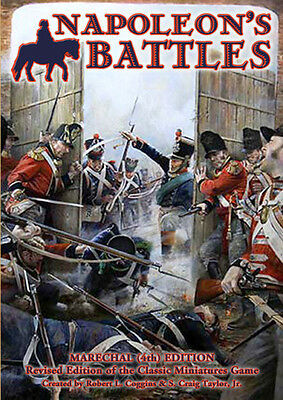 By Jim Naughton
By Jim Naughton
Introduction
The 4th Edition was published seven years ago. You may ask why I’m reviewing it now. There are a couple of reasons. First, there are new offerings in the figures market in 12mm/15mm scale. Although theoretically aimed at other rulesets, they can be easily applied to Napoleon’s Battles.
And because Napoleon’s Battles (hereafter NB) uses small bases, a ‘sabot base’ or piece of plastic card, a movement tray or similar device can take figures based for NB and apply them to other systems.
In effect, figures are a fungible asset and can be used for multiple rules. So I recommend those entering Napoleonics for the first time, to have a look at various systems, and base your figures in a way they can be multifunctional.
The second reason is that NB remains one of the few sets that allow playing a modest battle to conclusion in an afternoon. My group played battalion-level Napoleonics a long time ago, and Waterloo took a couple of days, Quatre Bras was an all-day affair, and we don’t talk about Leipzig. Many battles never saw a conclusion; we got bored and set up all over again (or shifted to Squad Leader or Tractics for a diversion).
The third reason is that it readily lends itself to campaigns. The fixed time scale allows the arrival of reinforcements based on proximity and having a battle end in an afternoon allows measurable progress on a weekly or bi-weekly schedule. I’ve built rules that allow players who own the GMT Napoleonic Wars board games to fight the battles (which are infrequent) in NB and apply the results to the cardboard forces on the map.
Finally, you can play the NB rules with almost any set of figures. The NB game was designed for 15mm based to NB scale, but if infantry and cavalry bases have a similar frontage the rules can be applied to other bases and scales. A little imagination and calculation and you can be in business.

Overview
The Marechal Edition is hard-cover and good quality. The actual rules run 107 pages, followed by 59 pages devoted to scenario design and unit charts. Sixteen pages of playing aids follow. Three historical scenarios and three ‘what if’ scenarios are included in the book.
It modestly revised the format, putting the rules that affected Movement in Movement Sections in the Standard and Optional Rules, etc. Making using the rules easier. There are changes from the first three editions addressing the biggest warts of the game.
The core rules MOSTLY remained the same. There were a couple of significant changes and a couple of large additions to the optional rules. I’ll deal with them in order of significance sorted by Standard and Optional.

Standard
Interpenetration
The original rules allowed units to freely interpenetrate other units that weren’t disordered or routed; e.g. no penalty. Interpenetrating a disordered or routed unit immediately disordered the moving unit.
The original reasoning was that the game units represented brigades with the flexibility of moving subunits around, allowing the moving unit to adjust to gaps presented by the stationary unit. An infantry brigade of 2,880 men occupies 45,000 square yards on the tabletop however arranged, but the soldiers physically occupy only 6,200 square yards. And generally, the troops are not spread amorphously in the formation but occupying discrete blocks with large gaps between blocks.
This was a source of heartburn for players groomed on battalion-level Napoleonics, where interpenetration was (righteously) heavily penalized.
The fourth edition now requires as a Standard Rule the moving unit to treat the interpenetration as ‘Rough Terrain’ which carries stiff penalties based on the standard of drill. With two brigades in ‘Column’, especially cavalry (whose stands are 2” deep) the penalty may be so stiff that interpenetration is impossible.
This change will force grognards to reconsider reserve placement and slows the action.
Built-up Areas
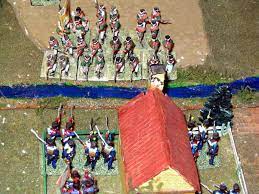
One of the warts I mentioned in Part I was the way built-up areas were handled. Once a unit ‘deployed’ into a built-up area it didn’t pay to assault it. But a hail of fire from infantry units and light artillery could rapidly disperse it. Particularly if the controlling player chose to ‘detach’ a couple of stands to garrison a small farm.
There are two changes. The first makes units ‘deployed’ in a built-up area much harder to hit in Fire. Like an artillery unit, a ‘doubled score’ is necessary to give one casualty. A net ‘zero’ fire modifier now has 25% chance of scoring ONE casualty. Through third edition, the chance of doing TWO casualties was 25% and 20% chance of a single casualty.
A typical 8-figure garrison was dispersed in five turns by a single unit, and additional units sped the process up. Now a single unit typically takes all day – so the stand of the British Guards at Hugomont and the KGL light infantry at La Haye Sainte is possible in fourth edition.
The rules for Combat are also quite different. Previously, the attacker used his standard formation modifier and the defender used his LINE modifier (best combat modifier) plus the defensive value of the buildings. This made assaults very chancey, because maneuvering is typically done in column. COLUMN modifiers are typically two or three numbers worse than LINE.
The NEW rule allows the attacker to use his LINE modifier even though in COLUMN if attacking a unit deployed in a built-up area. The reasoning is that street fighting is very much a battle of small units, and thus the difference between the two formations once the fight rages in the streets is minimal. The deployed defender still gets a bonus for the toughness of the buildings. This change makes the fight very fluid, leading to the attack/counterattack flow described in many battles.
Unit Size

The original rules had fixed unit sizes with an option to detach infantry stands to garrison small buildings and detach cavalry to escort generals. 4th Edition allows infantry units smaller than four stands and cavalry units smaller than three stands in historic orders of battle. This permits greater accuracy in behavior; for example, a brigade of two light battalions and two line battalions amounting to 24 figures can legally be represented as 12 LT and 12 LN. The point system still restricts units to the original sizes.
Optional
Combined Arms Attacks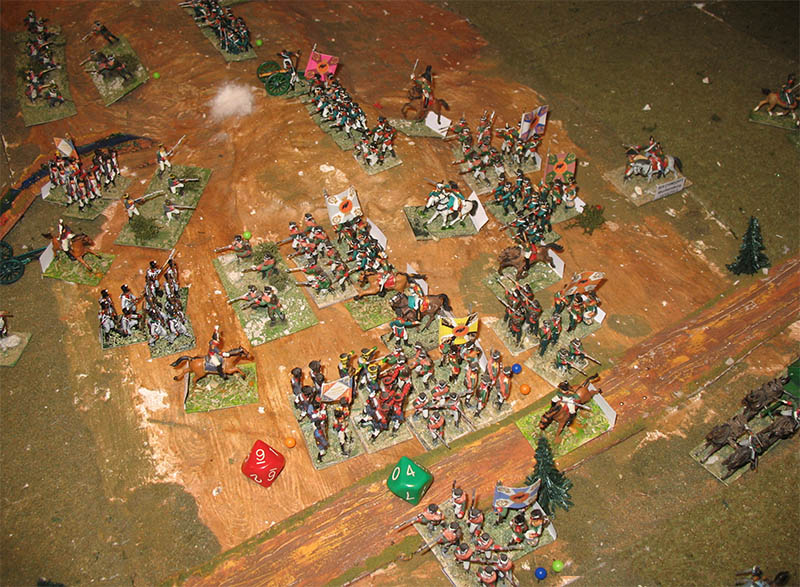
Originally the rules assumed the generals interacted freely to arrange attacks focusing both infantry and cavalry on the same target. Combined with restrictions on Emergency Formation Changes this produced a devastating attack. History shows that this wasn’t easily done even with well-trained troops.
This new rule requires the controlling player to declare ‘combined arms attack’ before moving the involved units. The first unit moves normally. The second unit must make a Response Test to enter combat. An attached general modifies the Test, and if two units have the same divisional commander, an additional modifier applies, making the mixed Advance Guard Divisions of the Austrian Army tastier.
Countercharging Cavalry
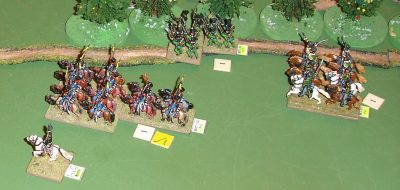
Before, a cavalry unit marked with a REACT marker contacted by another unit had one choice- Evading. Now it can use its REACT marker to countercharge. Thus making it ‘attacking cavalry’ and affecting its combat factor vs. infantry. No longer can an infantry unit crash into a cavalry unit with REACT marker and not suffer consequences.
Brigade Commanders
Original rules required attached generals for any attempt to Rally routed units. Units completely out of command (frequently happened to cavalry units that failed RECALL) were marked NO MOVE.
Now, units can Rally at -3 to the RESPONSE number, and out-of-command units get an opportunity to move by checking RESPONSE at -3
Optional Unit Ratings

One common complaint by gamers transitioning from battalion-level games to NB is the lack of fine gradations in troop types. For example, Bylandt’s Dutch-Belgian Brigade at Quatre Bras and Waterloo consisted of a Light Battalion, a Line Battalion and three Militia Battalions. Originally that unit was rated as DB MI, or militia based on the slight numeric superiority of the militia.
Now that unit can be rated DB LN ‘with militia or other poor quality troops’ having abilities between LN and MI avoiding the horrific ‘E’ dispersal rating. There are two pages of these new ratings, covering most of the situations found in historic orders of battle. Sorry to disappoint cavalry fanatics, but ‘lancers’ isn’t one of them.
Optional Cavalry Recall

A feature is Cavalry Recall. A cavalry unit involved in Combat that entirely routed the opponents must make a RESPONSE test (generally) at -2 to the die roll. Pass, the unit has the choice of being marked with a REACT marker or continuing the attack. Fail, the cavalry is immediately disordered and makes a move to combat contact with the closest unit to its front.
With normal cavalry (RESPONSE=5 or 6) and typical dispersal rating (‘C’) the combination of low odds plus fire and winner losses usually prevented more than two sequential charges.
A cavalry unit with a high response number and high dispersal rating (Old Guard HC, 8/A) with an attached ‘E’ General (+2) is a different animal. And anybody can roll a string of ones. Seen an entire corps destroyed and friends whisper of the ‘sandal in the overhead’ incident where a game ended in a spectacularly unlikely charge.
The optional rule limits the sequence to three successes, requiring the third successful recall attempt to place a REACT marker. And the second attempt is -4 instead of -2 with the third at -6.
Evaluation
Changing built-up area combat was a necessary correction. It feels right to me and works, but others may disagree. Small garrisons (the single stand occupying La Haye Sainte comes to mind) are not likely to make a day-long stand thanks to the big modifiers available for outnumbering the enemy. But it’s arguable that the real combat at La Haye Sainte was a day of skirmishing while fighting proceeded around it until Ney finally got serious.
The new rule on interpenetration is harsh. It adequately covers infantry in Line formation interpenetrating another Line. But it makes interpenetration much too difficult for cavalry columns interpenetrating cavalry columns during a thirty-minute turn. The authors have since offered an Optional Rule on their website https://napoleonsbattles.org. This limits the penalty to one inch of rough terrain movement regardless of formation.
Unit size has some potential issues, but if the authors’ advice to use them sparingly is followed the effect will be minimal. The danger results from the relatively simple fire arc rules. A unit can only target one other unit but can be targeted multiple times. The unit can only affect one of the opposing units with its defensive fire, but several units may shoot it resulting in probable disorder or even rout. This has the potential to get out of control very quickly in Design Your Own scenarios. A word to the wise, limit this.
I’m on the fence about combined arms attacks. Having a decent general lead the second unit is an obvious solution, but it will never be certain unless an ‘E’ general combines with an ‘8’ RESPONSE. My inclination is that the rule devalues cavalry with RESPONSE<’5’.
Countercharging Cavalry, Brigade Commanders, Optional Unit Ratings, and Cavalry Recall are excellent fixes to small problems, and are unlikely to have a profound effect every game.
Warts

The biggest omission in fourth edition is the absence of additional scenarios and the General’s List. http://www.rafaelpardoalmudi.com/NBscenarios.html among other sites offers many scenarios and links to a version of the General’s list. The authors’ website above has a couple of scenarios and a General’s list (currently inoperative).
But the authors showed me an alpha model of a new list that works well and asked that I share the link: http://napoleonsbattles.org:8080/armee-builder/abierto/utils/nb/generalesnb.xhtml. The General’s list will be linked to an army builder that makes developing scenarios or building points-based armies a breeze.
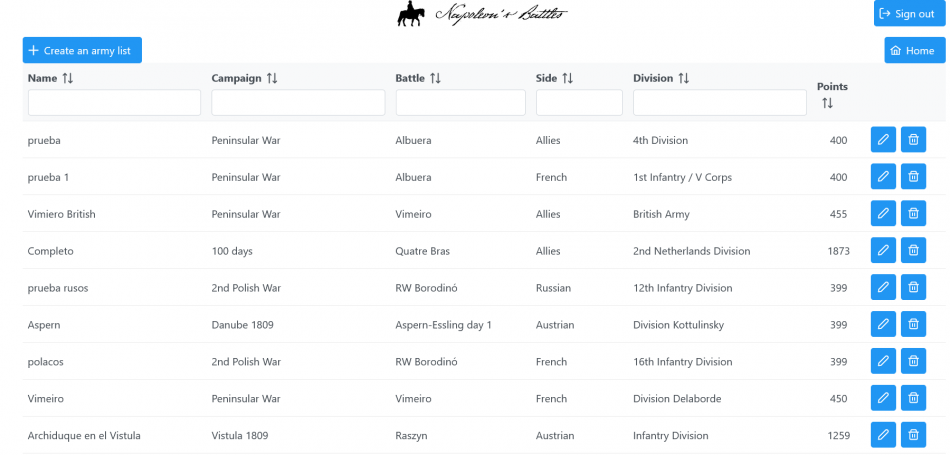
Conclusion
Fourth (Marechal) edition is still an excellent way to play large to medium battles of the Napoleonic Wars. It’s aged well and is still relevant today.
